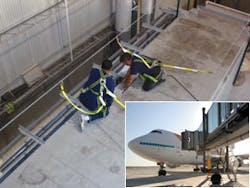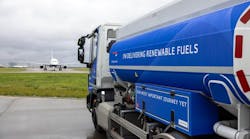For maintenance personnel working atop passenger boarding bridges, the possibility of a fall has presented a safety risk. Systems have been devised to address the potential hazard — but not without concern for functional maintenance performance or effective injury prevention. Now a prototype, ThyssenKrupp believes the new system could prove a more effective solution.
A lack of effective safety measures
The majority of bridges currently in use are not furnished with any type of fall protection for technicians who must access equipment and features from a bridge rooftop. “The primary reason is that the bridges consist of two or three tunnel sections that telescope to provide the operational range of motion required,” says Clay Ratliff, director of customer service and after sales at ThyssenKrupp Airport Systems, a supplier of PBBs and various pieces of ancillary equipment. “Since the tunnels collapse inside each other and the clearance between tunnels is very small, it is difficult to provide a substantial structural anchorage point for traditional horizontal lifelines.”
Though a number of bridges are equipped with a handrail on top of the largest tunnel, workers are left without provisions on the smaller, retractable segments. An additional method has been to use tie-off points strategically located on each tunnel. Requiring a technician to unhook and reattach at various locations, it leaves a worker vulnerable between points. “So really there is no protection with strategic tie-off points for the worker when they are walking up and down the tunnel. It’s only when they are at that specific work location that they can attach,” Ratliff says.
A traditionally accepted solution for PBB rooftop safety has been a fall arrest system, which attempts to prevent injury or death in the event of a fall. It is designed to bring a user to an abrupt stop below the edge of the roof. A horizontal lifeline is placed on or close to the roof of each tunnel, the cables and support anchors typically within an inch of the roof for accommodation inside an overlapping tunnel, he says. A fall is arrested by a safety harness, safety lanyard and horizontal lifeline. However, several aspects of the system have raised concerns with experts in the industry.
A system flawed
“The biggest concern with this arrangement is that the person can still be severely injured in the fall,” Ratliff says. “The tunnels are steel or glass construction with a variety of attached devices that could cause injury to a person falling off the edge. The apron area around the bridges is also congested with numerous ground support vehicles and equipment that could be in the path of the fall.”
Another troublesome aspect has been that the bridge can be positioned at variable heights and is most often angled at a downward slope that might be close enough to allow contact with the ground or nearby equipment, according to Ratliff.
Additionally, Ratliff says, cables are pre-tensioned at the time of install. Under constant pressure, those cables can stretch over the years and increase the total fall length. “There is no uniform procedure to make sure those cables continue to hold that same amount of pre-tension,” he says.
OSHA has required systems to limit freefall to 6 feet. “In reviewing existing designs, it was determined that a fall could exceed the 6-foot threshold,” he says.
The fall arrest system has also presented an operational hindrance. “Due to anchorage point load requirements, this system is typically only rated for one technician to be on the roof at a time,” Ratliff says. At the end of each tunnel section, a technician must also disconnect and reattach to the adjacent tunnel.
In the summer of 2007, the team at ThyssenKrupp began the process of developing a system under a design principle that had been previously overlooked in the industry — preventing a fall from occurring, or fall restraint.
Bucking convention
It was a request by a major airline that sent the company back to the design drawing board. “The way it developed was really just for one airline,” Ratliff says. “What happened was they asked us for a fall arrest solution. We and our biggest competitor both went to the airline and said, ‘Here is what we offer.’ They said, ‘Well, we would like something that can keep people from falling off.’ They were worried that if the airline put something on the roof for fall arrest, someone could still be injured.”
In addition to designing a system for fall prevention to eliminate any chance of injury, he says, the engineers were tasked with three specific requirements: the system had to be rated to a minimum of two technicians; the technician needed the ability to travel the entire length of the bridge without disconnecting; and the new system had to be designed to allow retrofitting to all makes and models of PBBs.
The team worked for months to configure a system. “We consulted with other experts in the field,” says Mark Jones, president of ThyssenKrupp Airport Systems. “It’s difficult to come up with something on a piece of equipment that’s moving with something that telescopes in and out, allows the worker to work and doesn’t impede the airport or airline from having additional equipment on top of the bridge.”
What emerged was a prototype that has now entered the second phase of testing.
As a method of fall restraint, the product was assembled to allow a maintenance technician access to areas on the bridge roof that require maintenance, but restrict movement so that a fall from the edge is not possible.
“It includes a method of attaching raised structural supports on each tunnel so as not to interfere with the normal extension and retraction of the bridge,” Ratliff says. “It also includes a method of spanning the entire length of the bridge using elevated continuous length cables as the lifelines. A critical element of the product is the ability to allow the cables to extend or retract with the bridge movement, but still be able to be pre-tensioned to the correct amount just prior to use and locked in place.”
The system includes the structural supports, horizontal lifeline cables, safety harness and lanyards, cable tensioning mechanism, cable locking mechanism and all necessary accessories to make a complete certifiable restraint system, Ratliff says.
The system is divided into two main components: the bridge reels and cable, which are installed on each bridge and never removed, and a tensioning kit that is removable and only placed on the support post when a technician requires access. “This significantly reduces the cost by requiring the customer to only purchase a few tensioning kits for each airport,” Ratliff says.
Additionally, the system can be retrofitted on all types of existing passenger boarding bridges as well as newly manufactured bridges. “That’s one of the things integral to the design, that we had to make sure it could be retrofitted onto any bridge out there,” Ratliff says.
Using two cables along both sides of the tunnel at an approximate height of 3.5 feet, the system was designed to clear rooftop-mounted equipment. Two lanyards, one attached to each cable, are used so that the technician can access any part of the roof without the possibility of falling off either edge.
“The lanyard lengths are designed to allow the technician to actually sit on the edge of the tunnels without falling over the edge,” Ratliff says.
To provide rigid anchorage points required by OSHA for a horizontal lifeline system, the support structure consists of a series of adjustable raised posts attached to the structural end elements or corner angles of each tunnel section, he says. The anchorage points can be welded, bolted or clamped to the tunnel sections to accommodate a variety of tunnel configurations. The cable is guided through brackets specially designed to provide a manual pass through, so the technician does not have to disconnect the lanyard from the cables throughout the entire length of the bridge. The end anchorage point for the cables is located on a post attached to the rotunda or the rotunda end of the smallest tunnel.
The forward ends of the cables are attached to reels located on each side of the tunnel, which in normal bridge operation maintain sufficient tension on the cables to keep from sagging excessively and contacting the roof, Ratliff says. The reels also allow the cables to extend under tension as the bridge extends. A removable tensioning device and gauge are used to apply the adequate amount of tension on the cables.
Employing the system
Access is granted by a service ladder or an external man lift, and the technician enters at the cab end of the bridge where the reels are located. The technician then attaches a safety lanyard to the tie-off point on the posts and installs the cable tensioning device kit, which isolates the cable to the tensioning device and results in a pre-tensioned cable lifeline, he says. A manual mechanism is provided to pre-tension the cables before use, and a tension meter is included to allow the technician to set and read the proper pre-tension in the cables. Once the pre-tension is properly set and locked, the technician can connect the lanyards to the cables and conduct maintenance operations anywhere along the length of the tunnels.
“Normal maintenance procedures for lockout and tag out should always be followed to prevent others from trying to operate the bridge while maintenance is being performed,” Ratliff says.
The system also features an option to electrically monitor the cable lock mechanism. “Whenever it is engaged, a sensor can detect that and provide a signal to the PBB electrical controls to prevent the bridge from moving and provide an indicating alarm to the operator,” he says. “This will prohibit the bridge from operating while the cable lock is engaged to prevent damage to the bridge.”
Don Mesecher, president of DK Consultants LLC, reviewed ThyssenKrupp Airport Systems’ design. He recommended that airlines or airports looking to implement the system in the future should subject it to regular checks. “It is a more complicated, more mechanical device, which in our opinion is going to require more maintenance and inspection to ensure there is no failure for the device,” he says. “If they do this, they need to include this in their preventative maintenance program. They can’t just put it up and forget about it.”
Ratliff agreed, stating, “The system should be included in a comprehensive preventative maintenance inspection. One of the great things about this system is that it only has one moving part and we are using proven technology from the fall protection industry. No actual service is required, only visual inspection and it should add only a few minutes to the procedure. We felt this was one of the things lacking in other systems. In most cases no inspection was required, and we believe that is paramount with anything regarding safety.”
Future in the field
The company expects to implement the system in the field in April and anticipates a demand. “We are expecting to see it in the majority of specifications we see,” Ratliff says. “We will make all of our customers aware that this is available.”
Though there has been no stringent industry standard that requires fall protection systems aboard PBB rooftops, Ratliff says it could be on the horizon. “We’ve had several airport safety directors come back and say fall protection was on OSHA’s radar, and they needed something to address that.”
Keeping safety in mind
With or without an industry-wide requirement, the potential for a fall still exists for technicians working aboard PBB rooftops. Mesecher says personnel should maintain an awareness of the danger. “A lot of times when I’m out on the ramp … safety is not on the minds of people as it ought to be,” he says. “People can fall off a bridge and they need to remember that could happen. Just to reiterate the importance of tying off, whether it’s with this system or another system.”





